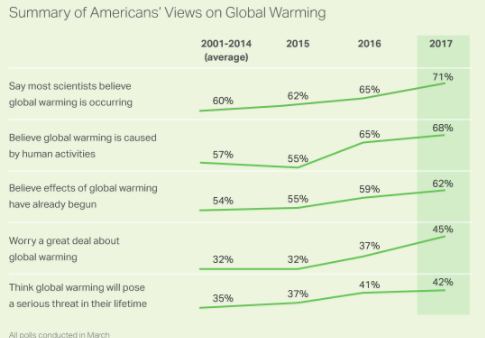(Dan here…I am always looking for new writers that might make a good fit for AB. Jeff is in the field of behavioral economics in the private sector. I know that the topic of climate change is a hot one here, but remember this is his first here…) by Jeff Soplop Climate Change and Environmental Frames: The Consensus-Action Disconnect American attitudes toward the environment generally – and climate change specifically – could long be described as ambivalent. The Trump Administration seized on this ambivalence and spent the past year furiously censoring climate change scientists and scrubbing the EPA website of any references to dangerous words such as “greenhouse gases” and “science.” While survey research shows more and more Americans recognize climate
Topics:
Dan Crawford considers the following as important: US/Global Economics
This could be interesting, too:
Joel Eissenberg writes How Tesla makes money
Angry Bear writes True pricing: effects on competition
Angry Bear writes The paradox of economic competition
Angry Bear writes USMAC Exempts Certain Items Coming out of Mexico and Canada
(Dan here…I am always looking for new writers that might make a good fit for AB. Jeff is in the field of behavioral economics in the private sector. I know that the topic of climate change is a hot one here, but remember this is his first here…)
by Jeff Soplop
Climate Change and Environmental Frames: The Consensus-Action Disconnect
American attitudes toward the environment generally – and climate change specifically – could long be described as ambivalent. The Trump Administration seized on this ambivalence and spent the past year furiously censoring climate change scientists and scrubbing the EPA website of any references to dangerous words such as “greenhouse gases” and “science.”
While survey research shows more and more Americans recognize climate change is caused by human activities and believe the effects have already begun, only 45% say they worry “a great deal” about it. Despite such shifts in public attitude, it’s hard to make a case that Americans are actually growing more concerned; when President Trump announced on June 1, 2017, that the US would withdraw from the Paris Climate Agreement, his approval numbers in the following weeks didn’t take a hit.
Some might chalk this resilience up to a diehard core of Trump supporters, who were pleased with the announcement, propping up his approval ratings. But research from Yale’s Program on Climate Change Communication shows that almost 70% of registered voters want the US to stay in the agreement (including majorities of Democrats, Republicans and Independents), while only 13% don’t.
While American views of climate change are continuing to shift toward concern, and an overwhelming majority of the country wants to stay in the Paris Climate Agreement, President Trump has not faced political consequences for his blatant attacks on science and the environment.
So how can the semblance of consensus be translated into action?
New research suggests that framing of environmental issues might be part of the answer. A recent paper published in the Land Use Policy journal, for example, tested two framing mechanisms to determine their effects on participants’ willingness to accept an incentive-based planning policy designed to prevent urban sprawl: goal framing, which uses language focused on either increasing the personal benefits or reducing negative externalities involved; and attribute framing, which highlights positive or negative aspects of a policy (in this case a subsidy or fee).
Participants were randomly split into four different groups and received messaging using either goal or attribute framing, which included a positive or negative emphasis embedded in the message. The test was carried out in Switzerland, so their direct democracy process could be used to accurately gauge “acceptance” of the frames. This allowed the researchers to determine whether people actually voted favorably for the policy rather than just indicating they would on a survey.
The results show that frames do matter, which isn’t a surprise. But more importantly, they demonstrate the effect different frames had on different stakeholders’ votes, in this case landowners versus non-landowners. In other words, it’s not just the frames that matter, but how and to whom they are applied.
In another recent study, risk framing, which draws on the human predilection to prioritize mitigating risk over the opportunity of benefits, was used to assess the impact on high school students’ perceptions and willingness to act to mitigate climate change. Students were presented with an article that followed a similar format but differed by framing the risks of climate change in four different areas: agriculture, health, community or environment. The results showed the agriculture and environment frames were most likely to motivate students to act to mitigate climate change.
These two studies – which are representative of a growing body of research – show that using behavioral framing methods, and, crucially, tailoring those methods to the specific audiences, are essential to driving action on environmental issues.
As evidence of climate change continues to mount, surveys are likely to continue showing Americans’ views of climate change trending toward consensus. But political will to reward action – or punish inaction – has, so far, not materialized.
While environmental framing isn’t a new concept, the rise of social media and digital channels offer far more scope for its use and refinement. The power of framing effects demonstrates that environmental advocates would do well to go beyond save-the-planet-style mantras and focus on testing and tailoring framing methods to deliver the right message to the right audience.


